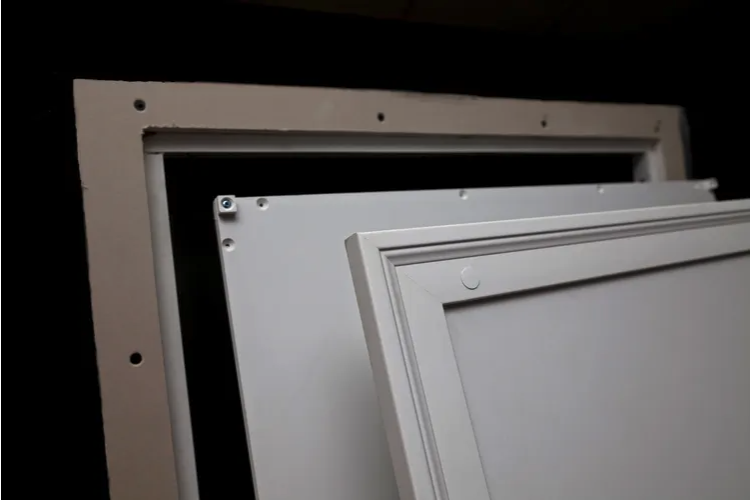Tru-Seal Attic Hatch challenges the conventional attic hatch design. Rather than pushing into the attic for access, it is fastened on from underneath. In order to gain access into the attic, simply remove the screws and the doors are placed in the interior rather than into the attic.
Patent Pending Tru-Seal Attic Hatch is a 2 door system. The first door (Seal Door) is installed right after the drywall stage. This allows the attic to be sealed up during the rest of the building process.
The second door (Finish Door) is installed right at the end of the finishing stage. This is a decorative door that will cover up any stippling, paint or scratches that the Seal Door sustained during the building process.
By fastening the door from underneath, we are able to use friction fit batt insulation in the cavity which not only eliminates the half-inch space that a conventional door has but also allows us to insulate that cavity to the same R-Value as the rest of the attic.
The conventional design consists of a door that sits on a gasket (weather-stripping). This door pushes into the attic to gain access. In order for this door to push into the attic, there needs to be a half-inch of uninsulated space all the way around the door. This uninsulated space allows cold air from the attic to meet right at the gasket.
This door also relies on gravity to form a tight seal against the gasket. If the door is not sitting nice and tight on that gasket, warm interior air is now able to escape into the attic where it meets that cold attic air in your access where it can create frost. This frost build-up can have dramatic effects in the springtime when it melts causing ceiling damage.
Tru-Seal eliminates the half-inch of uninsulated space by being fastened on from underneath. We are now able to fully insulate the hatch cavity with friction-fit batt insulation.
By being fastened on, we maintain a vapour barrier seal that prevents any interior air from escaping into the attic.
Tru-Seal Attic Hatch is the right choice for you if…
- You want to avoid any frost issues in the future
- You want a properly sealed and insulated attic access for your energy-efficient home
- You want a discreet and subtle hatch that is actually lighter and causes less strain on your body
- You want to avoid having to replace your faulty conventional attic hatch in a few years


